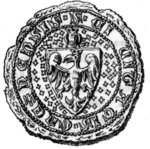Gniezno
|
|
Gniezno (pronounced: Missing image
Ltspkr.png
Image:Ltspkr.png
['gɲȋεznɔ]) is a town in central Poland, some 50 km east of Poznan, inhabited by about 73,000 people. Situated in the Greater Poland Voivodship (since 1999), previously in Poznan Voivodship.
| Contents |
History
There are archeological traces of human settlement since the late Paleolithic. Early Slavonic settlements are on the Lech Hill and the Maiden Hill are dated to 8th century and the ducal stronghold was founded just before AD 800 on the Lech Hill, and surrounded with some fortified suburbs and open settlements.
Legend of Lech, Czech and Rus
According to the legends: three brothers Lech, Czech and Rus were penetrating the wilderness to find a place to settle. Suddenly they saw a hill with an old oak and an eagle on top. Lech said: this white eagle I will adopt as am emblem of my people, and around this oak I will build my stronghold, and because of the eagle nest [Polish: gniazdo] I will call it Gniezdno [modern: Gniezno]. The other brothers went further on to find a place for their people. Czech went to the South and Rus went to the East.
Cradle of the Polish State
In 10th century Gniezno became the main city and capital of the early Piast dynasty rulers: Mieszko I and Boleslaw Chrobry, the founders of the Polish State.
Gniezno meeting 1000
It is here that the Gniezno Congress (Meeting at the tomb of Saint Adalbert) took place in the year 1000 AD, during which Boleslaus I the Brave (Boleslaw Chrobry), the first king of Poland, received Otto III, the Emperor of Germany. The two monarchs celebrated the foundation of the Polish ecclesiastical province (archbishopric) in Gniezno, with newly established bishoprics in Kolobrzeg for Pomerania; Wroclaw for Silesia; Krakow for Little Poland and already existing since 968 bishopric in Poznan for western Greater Poland.
Gniezno_panorama.jpg
Royal coronation site
Gniezno cathedral witnessed royal coronations of Boleslaus I the Brave in 1024, his son Mieszko II Lambert in 1025. The cities of Gniezno and nearby Poznan were captured, plundered and destroyed in 1038 by the Czech duke Bretislav, what pushed the next Polish rulers to move the Polish capital to Cracow. The archepiscopal cathedral was reconstucted by the next ruler Boleslaus II of Poland who was crowned king here in 1076.
In the next centuries Gniezno evolved as a regional seat of eastern part of Greater Poland, and in 1238 municipal autonomy was granted by the duke Wladislaw Odonic. Gniezno was again the coronation site in 1295 and 1300.
Regional site of Greater Poland
The city was destroyed again by the Teutonic Knights invasion in 1331, and after an administrative reform became a county site in the Kalisz Voivodship (since 14th century till 1768). Gniezno was hit by heavy fires in 1515, 1613, was destroyed during the Swedish wars of the 17th-1th centuries and by a plague of 1708-1710. All this caused depopulation and economic decline, by the city was soon revived during the 18th century to became the Gniezno voivodship site in 1768.
Archbishops of Gniezno
Gniezno's Roman Catholic archbishop is traditionally the Primate of Poland (Prymas Polski). After the partitions of Poland the see was often combined with others, first with Poznan and then with Warsaw. In 1992 Pope John Paul II reorganized the Polish hierarchy and the city once again had a separate bishop. Cardinal Jozef Glemp, who had been archbishop of Gniezno and Warsaw and retained Warsaw, was designated to remain Primate until his retirement, but afterward the Archbishop of Gniezno, at present Henryk Muszynski, would again be Primate of Poland.
Royal coronations in Gniezno cathedral
- 25 December 1024 - Boleslaus I the Brave
- 25 December 1025 - Mieszko II Lambert
- 25 December 1076 - Boleslaus the Generous
- 26 June 1295 - Przemysl II and his wife Margaret
- August 1300 - Wenceslaus II of Bohemia
Historical population
- 1980: 62,400 inhabitants
- 1990: 70,400 inhabitants
- 1995: 71,000 inhabitants
Education
- The Gniezno School of Humanism and Management - Millennium(Gnieźnieńska Wyższa Szkoła Humanistyczno-Menedżerska Milenium
- The Archiepiscopal Eclessaitical Seminary (Arcybiskupie Seminarium Duchowne)
Arts and Culture
- Aleksander Fredro Theatre (Teatr im. A. Fredry)
- Museum of the Polish State Origins (Muzeum Początkˇw Państwa Polskiego)
Major corporations
See also:
External link:
- Gniezno homepage (http://www.gniezno.home.pl/) (English version available), from which much of the above was taken and adapted.de:Gniezno

